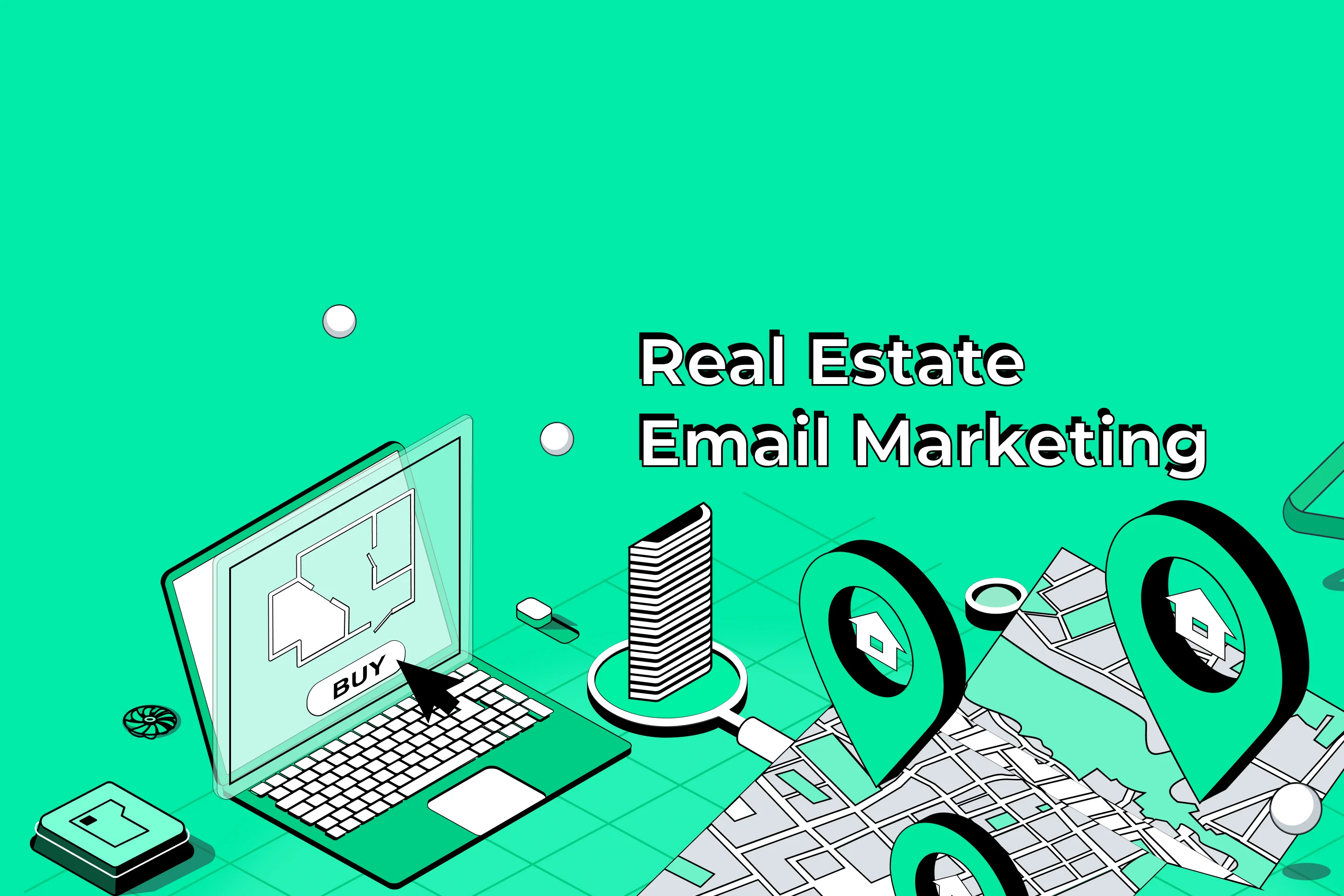Email Marketing Statistics and 8 Actionable Takeaways From 2017
If one were to collate all the facts and stats on email marketing into one document, it would take a while.A few months, or even years.So, we have used our experience and expertise to find the 8 most useful email marketing statistics.As a bonus, we are also going to be following up each statistic with relevant actionable takeaways to help supercharge your email marketing strategy.
1. Email Marketing is Still Number One for Marketing Professionals
According to the State of 2016 Digital Marketing report from DemandWave, 95% of marketing professionals use email as a communication channel with their customers. This puts it ahead of all other forms of marketing.Takeaway: With the same report highlighting the fact 75% of professionals saying email is the number one driver of leads, the bottom line is, email marketing works. Whether you are just starting out or an established business, you need to make email the central plank of your marketing strategy.Who Gets It Right:Creating a great email doesn?t need to be complicated. Take a look at this example from Bonobos, a men’s apparel brand.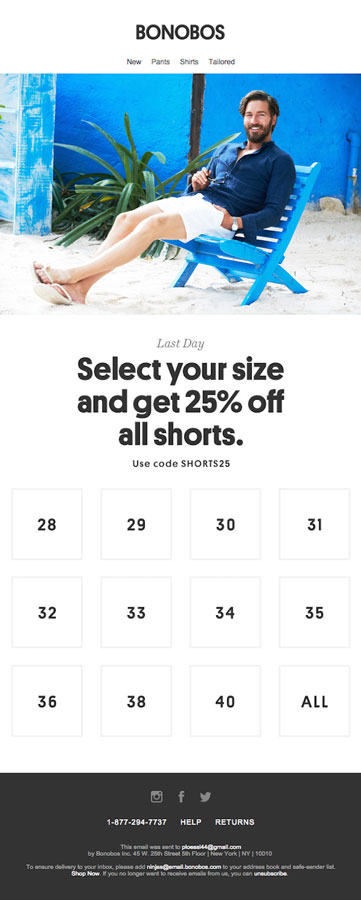 (Source: Bonobos.com)As you can see, all the subscriber needs to do is click on his size and he is on the website. It is a simple, direct, and interactive format. Together with a special offer, it is a winning combination.
(Source: Bonobos.com)As you can see, all the subscriber needs to do is click on his size and he is on the website. It is a simple, direct, and interactive format. Together with a special offer, it is a winning combination.
2. Influence of Email Marketing
Sixty percent of consumers say email marketing influences their decision-making when it comes to purchasing.Takeaway:With clever email design, promoting your products can prove lucrative for your business. Let’s take a look at what the big boys do:Who Gets It Right: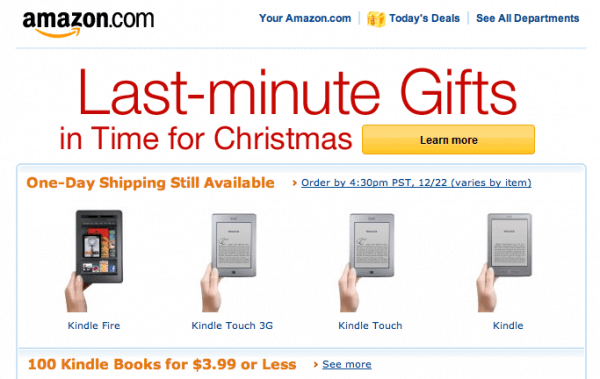 (Source: Amazon.com)In the run up to Christmas, during that last minute rush to buy presents for loved ones, Amazon gift us with an email to make things easier.The king of e-commerce highlights one its flagship products, the Kindle, but also displays the full range of products from the Fire to Paperwhite. If your nearest and dearest already have an e-reader, they encourage you to buy them an e-book.This is an epic example of how to use product promotion to influence your subscribers.
(Source: Amazon.com)In the run up to Christmas, during that last minute rush to buy presents for loved ones, Amazon gift us with an email to make things easier.The king of e-commerce highlights one its flagship products, the Kindle, but also displays the full range of products from the Fire to Paperwhite. If your nearest and dearest already have an e-reader, they encourage you to buy them an e-book.This is an epic example of how to use product promotion to influence your subscribers.
3. Email is More Effective Than Social Media. A Lot More.
When it comes to customer acquisition, there’s little room for doubt. Email is 40 times more effective than social media for driving traffic and sales.Takeaway: Much talk of online marketing focuses on social media, but don?t overlook the effectiveness of email. Facebook, Twitter, and Youtube definitely have their place, but email still reigns.Who Gets It Right:Lonely Planet, a world-leading travel magazine, creates informative emails filled with interesting articles on fascinating destinations around the globe – eminently shareable content. So the travel brand adds social media icons, making it easy for subscribers to share with their friends and family:![]() (Source: Lonelyplanet.com)With 92% of customers saying they believe in referrals from their friends and family over all other forms of marketing, it is a potentially lucrative marketing channel. Yet only 6% of marketers say they have mastered the art of word of mouth (WOM) marketing. Integrating your email campaigns with a social media strategy is a step in the right direction.
(Source: Lonelyplanet.com)With 92% of customers saying they believe in referrals from their friends and family over all other forms of marketing, it is a potentially lucrative marketing channel. Yet only 6% of marketers say they have mastered the art of word of mouth (WOM) marketing. Integrating your email campaigns with a social media strategy is a step in the right direction.
4. Mobile is Taking Over
Figures suggest that 54% of emails are opened for the first time on mobile devices.Takeaway:Ensure you have a mobile friendly design. This goes beyond simply having a single column template, You should keep your copy concise and leave plenty of space for subscribers to click on the call to actions (CTAs).Who Gets It Right: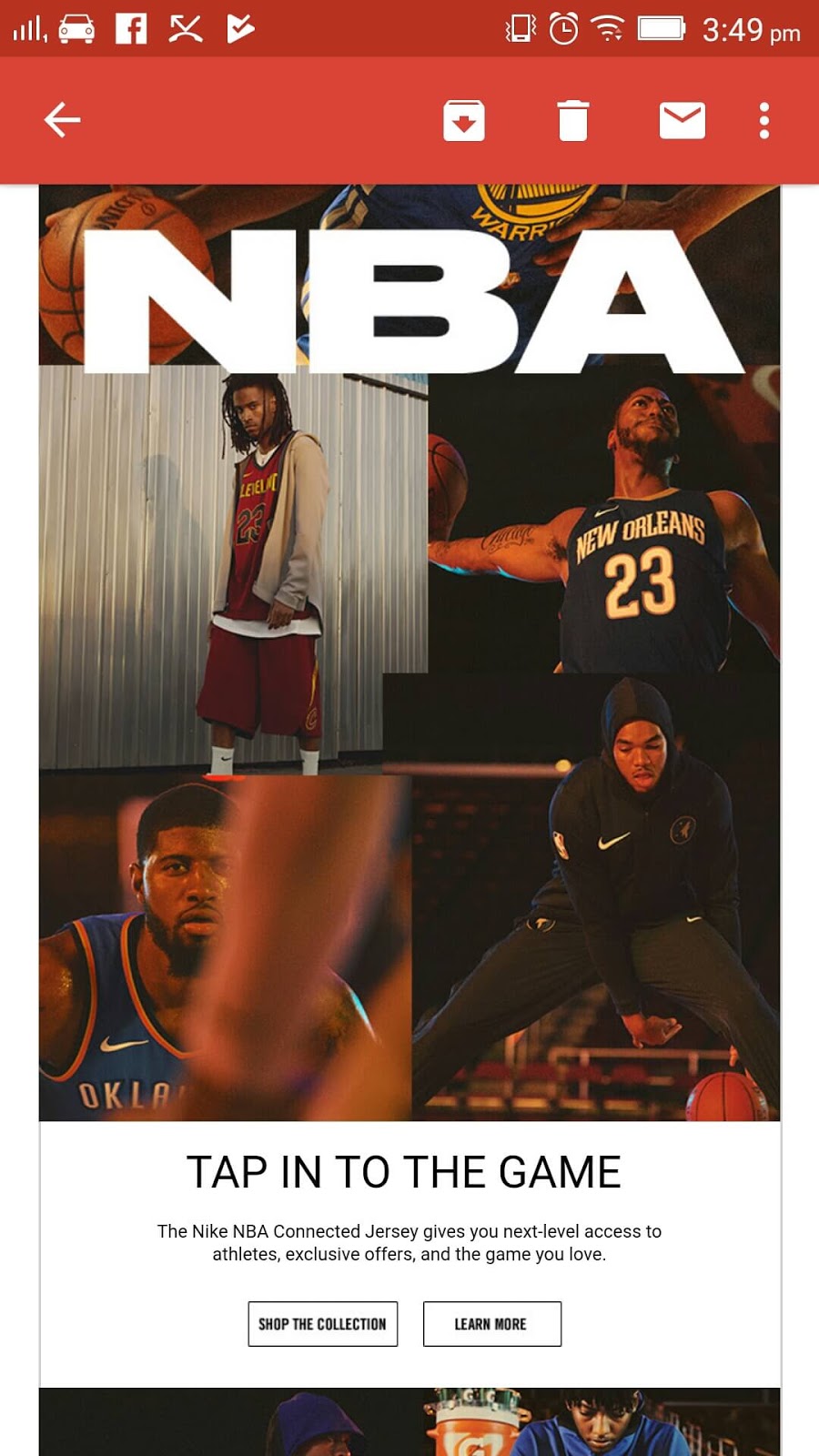 (Source: Nike.com)Sports apparel giant, Nike, knows a thing or two about marketing and they deliver brilliantly efficient emails. This responsive email above ticks all the boxes.
(Source: Nike.com)Sports apparel giant, Nike, knows a thing or two about marketing and they deliver brilliantly efficient emails. This responsive email above ticks all the boxes.
- Minimalistic, skimmable content
- Clear CTAs
- Single column
- Space to click on the links
- Smart use of images
5. Segment Campaigns For Better Conversion
Here’s a startling stat. The click-through rate (CTR) for segmented email campaigns is 100.95% higher than non-segmented campaigns.
Takeaway
Even if your business caters to just one niche or offers a limited range of products, your subscribers will still have their own individual interests and needs. There is a number of ways you can segment your email list:
Age
If you are selling vacations, for example, age can be a significant factor. A typical 20 year old college student will be far more interested in your Spring Break campaign than a 50 year old business person would be.
Gender
This is useful if you are a business selling gender specific products like clothing.
Location
Particularly relevant for events or international businesses. Keeping your emails relevant to thesubscribers locations can boost engagement and CTR. A good example is if you have two events, one in New York and another in Los Angeles, segmenting your emails to those specific locations will ensure the content will be relevant and see high conversion rates.
Previous purchases
Once again, the master of e-commerce, Amazon, sets the standard here. By tracking what your customers have bought before, you can promote related or supplementary products.
Active/Inactive subscribers
You should constantly review your email list. An engaged and active email list is a healthy one. If you are sending a weekly email and some of your subscribers haven?t opened a single email for three months, move them to a different segment as they are dragging your sender score down, making it more likely for your emails to end up in spam folders. Once you have identified the inactive subscribers, you should send them another email offering an incentive to draw them back to your brand.Who Gets It Right:If you have taken a free trial with Buffer, the social media management app, it will send well-timed emails reminding you to confirm your subscription.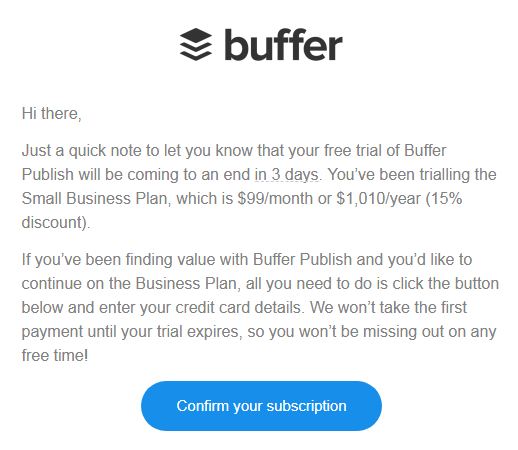 (Source: Buffer.com)This kind of email can only be achieved through segmentation. The friendly, personal tone ensures the email will not feel pushy. Additionally, there is a reassuring message that the customer will not be charged until their trial expires.Each of these factors help generate a healthy reputation and goodwill towards the brand.
(Source: Buffer.com)This kind of email can only be achieved through segmentation. The friendly, personal tone ensures the email will not feel pushy. Additionally, there is a reassuring message that the customer will not be charged until their trial expires.Each of these factors help generate a healthy reputation and goodwill towards the brand.
6. Watch Out for the Spam Trap
Twenty-one percent of permission based emails around the globe ended up in the spam folder in 2015. In the US, it’s 24%.Takeaway: No business wants to end up in the spam folder. This is one of the key reasons why you should keep your list of subscribers fresh, with a high open rate. A good benchmark to aim for is around 24.79%, though this varies across different industries.Some email providers, such as Gmail and Outlook, block emails with low open rates, even if the recipient had given permission.Occasionally, your email could end up in the spam folder through no fault of your own. If another business or person sends a spammy email, it affects the deliverability for anyone sharing the same IP address, which is why we are so strict with spammers, for example.It is also the law, as neatly detailed by the guys at MailChimp:
- Never use deceptive headers, From names, reply-to addresses, or subject lines.
- Always provide an unsubscribe link.
- The unsubscribe link must work for at least 30 days after sending.
- You must include your physical mailing address.
Who Gets It Right:The overall message is to be a responsible email sender and follow the guidelines.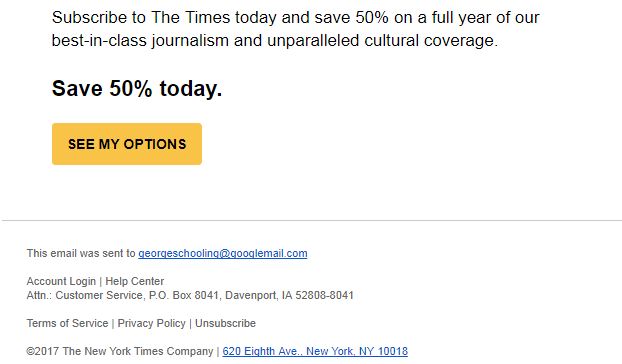 (Source: Nytimes.com)Every email from the New York Times has this footer, which includes the ?unsubscribe? button and the physical address. These simple steps will minimize the risk of your campaigns ending up in the spam folder.
(Source: Nytimes.com)Every email from the New York Times has this footer, which includes the ?unsubscribe? button and the physical address. These simple steps will minimize the risk of your campaigns ending up in the spam folder.
7. Personalized Subject Lines Get Opened
A well thought-out and crafted personalized subject line is 22.2% more likely to get opened.Takeaway: There is no overstating the importance of subject lines. It is effectively a window to your email. Without a good subject line, all the hard work put into producing high quality content will go to waste.So, what makes a great personalized subject line?As the great American writer, Dale Carnegie, once said: ?Remember that a person’s name is to that person the sweetest and most important sound in any language.?As appealing as it could be to simply ask for the email address on the signup forms, make sure you at least ask for their names, which you can then use for marketing campaigns.Of course, you want to be careful not to overdo it. The novelty will wear off quickly for your subscribers if you use their name in every single email.And look beyond the name. With segmentation, you can even tailor the subject line to the location or interests of your subscribers.Who Gets It Right:Twitter have mastered the art of personalizing emails to reflect on who you follow: (Source: Twitter.com)I follow The Economist, so Twitter sent me this email, simply saying that ?The Economist’s Tweet was featured in the news,? which I am interested in. Also, note it doesn?t give any more information, which entices me to open the email.Short, succinct, and personal.A winning combination.
(Source: Twitter.com)I follow The Economist, so Twitter sent me this email, simply saying that ?The Economist’s Tweet was featured in the news,? which I am interested in. Also, note it doesn?t give any more information, which entices me to open the email.Short, succinct, and personal.A winning combination.
8. Content Matters
A survey by the Direct Marketing Association (DMA) found that only 42% of marketers say only part or none of the email content is relevant to subscribers.Takeaway: This is a particularly common issue if you are a small business with limited resources. Quality content takes time to generate and put together. The DMA also says 25% of marketers have trouble getting content for email campaigns, one of the top challenges for marketing teams in executing a successful email campaign.You should factor this into the frequency of your email sends. If you don?t have enough content to fill a daily email, switch to a weekly send. Additionally, consider how much content you should put into an email. After all, the average time people spend on an individual email is just 11.1 seconds.Who Gets It Right: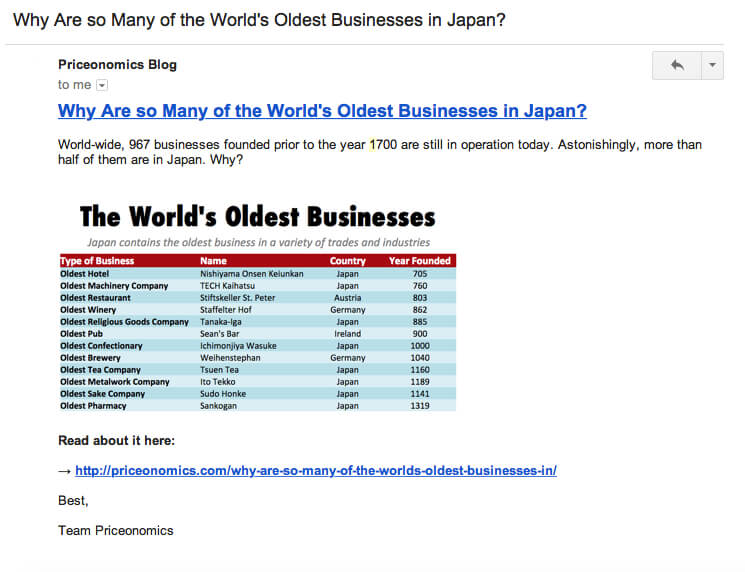 (Source: Priceonomics.com)It is an excellent case study in delivering one piece of killer content. Tailored for Priceonomics readers, who are specifically interested in all types of data and generic yet interesting knowledge.Notice the minimalist approach taken to the email here, with the title, one sentence, and the table of businesses.To find out more, you have to click through on the link, which should be the main purpose of any marketing email, to drive traffic to your site.An efficient way of using short, informative content to deliver enticing marketing emails.
(Source: Priceonomics.com)It is an excellent case study in delivering one piece of killer content. Tailored for Priceonomics readers, who are specifically interested in all types of data and generic yet interesting knowledge.Notice the minimalist approach taken to the email here, with the title, one sentence, and the table of businesses.To find out more, you have to click through on the link, which should be the main purpose of any marketing email, to drive traffic to your site.An efficient way of using short, informative content to deliver enticing marketing emails.
Conclusion
Email has been one of the top marketing channels for over a decade, bettered only by referrals and WOM. Far more effective with reaching mass audiences than social media, marketers have learned to harness the full potential of email campaigns by segmenting subscribers lists, personalizing subject lines, and creating informative, relevant content.There continues to be challenges ahead, but the future of email marketing remains bright as the format continues to evolve, becoming evermore personal, targeted, and effective. The respected Radicati group also expects to see 246 billion emails being sent and received, per day by 2019.Here’s the last killer stat: Email marketing generates a return on investment of $44 for every $1 spent.If you’re ready to take your email marketing to the next level, in minutes, click here and create a free account with DirectIQ.








